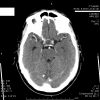Pituitary apoplexy following shoulder arthroplasty: a case report
- PMID: 21729259
- PMCID: PMC3141720
- DOI: 10.1186/1752-1947-5-284
Pituitary apoplexy following shoulder arthroplasty: a case report
Abstract
Introduction: Pituitary apoplexy following a major surgical procedure is a catastrophic event and the diagnosis can be delayed in a previously asymptomatic patient. The decision on thromboprophylaxis in shoulder replacements in the absence of definite guidelines, rests on a careful clinical judgment.
Case presentation: A previously healthy 62-year-old Caucasian male patient who underwent shoulder arthroplasty developed hyponatremia resistant to correction with saline replacement. The patient had a positive family history of deep vein thrombosis and pulmonary embolism and heparin thromboprophylaxis was considered on clinical grounds. The patient developed hyponatremia resistant to conventional treatment and later developed ocular localizing signs with oculomotor nerve palsy. The diagnosis was delayed due to other confounding factors in the immediate post-operative period. Subsequent workup confirmed a pituitary adenoma with features of pituitary insufficiency. The patient was managed successfully on conservative lines with a multidisciplinary approach.
Conclusions: A high index of suspicion is required in the presence of isolated post-operative hyponatremia resistant to medical correction. A central cause, in particular pituitary adenoma, should be suspected early. Thromboprophylaxis in shoulder replacements needs careful consideration as it may be a contributory factor in precipitating this life-threatening condition.
Figures
Similar articles
-
Intraoperative hypovolemia as a possible precipitating factor for pituitary apoplexy: a case report.J Med Case Rep. 2023 Feb 10;17(1):53. doi: 10.1186/s13256-022-03738-4. J Med Case Rep. 2023. PMID: 36759850 Free PMC article.
-
Fatal pulmonary embolism following shoulder arthroplasty: a case report.J Med Case Rep. 2009 Jul 31;3:8708. doi: 10.4076/1752-1947-3-8708. J Med Case Rep. 2009. PMID: 19830239 Free PMC article.
-
Surgical treatment of a 72-year-old patient with headache, hyponatremia and oculomotor nerve palsy: a case report and literature review.Gland Surg. 2021 Jan;10(1):364-370. doi: 10.21037/gs-20-517. Gland Surg. 2021. PMID: 33633993 Free PMC article.
-
Isolated Third Cranial Nerve Palsy in Pituitary Apoplexy: Case Report and Systematic Review.J Stroke Cerebrovasc Dis. 2021 Sep;30(9):105969. doi: 10.1016/j.jstrokecerebrovasdis.2021.105969. Epub 2021 Jul 22. J Stroke Cerebrovasc Dis. 2021. PMID: 34303962
-
[Pituitary apoplexy following coronary bypass surgery: A case report and literature review].Rev Med Interne. 2020 Dec;41(12):852-857. doi: 10.1016/j.revmed.2020.07.001. Epub 2020 Aug 13. Rev Med Interne. 2020. PMID: 32800377 Review. French.
Cited by
-
Heparin-Induced Pituitary Apoplexy Presenting as Isolated Unilateral Oculomotor Nerve Palsy: A Case Report and Literature Review.Case Rep Endocrinol. 2019 Oct 9;2019:5043925. doi: 10.1155/2019/5043925. eCollection 2019. Case Rep Endocrinol. 2019. PMID: 31687223 Free PMC article.
-
Pituitary Apoplexy Following Elective Total Hip Replacement.Cureus. 2023 Jun 18;15(6):e40600. doi: 10.7759/cureus.40600. eCollection 2023 Jun. Cureus. 2023. PMID: 37337556 Free PMC article.
-
Pituitary apoplexy after surgery for cervical stump adenocarcinoma: A case report and literature review.Oncol Lett. 2024 Jun 28;28(3):411. doi: 10.3892/ol.2024.14543. eCollection 2024 Sep. Oncol Lett. 2024. PMID: 38988450 Free PMC article.
-
Intraoperative hypovolemia as a possible precipitating factor for pituitary apoplexy: a case report.J Med Case Rep. 2023 Feb 10;17(1):53. doi: 10.1186/s13256-022-03738-4. J Med Case Rep. 2023. PMID: 36759850 Free PMC article.
-
Multidisciplinary management of pituitary macroadenoma.World J Methodol. 2025 Sep 20;15(3):97694. doi: 10.5662/wjm.v15.i3.97694. eCollection 2025 Sep 20. World J Methodol. 2025. PMID: 40881218
References
-
- Steele A, Gowrishankar M, Abrahamson S, Mazer CD, Feldman RD, Halperin ML. Postoperative hyponatremia despite near-isotonic saline infusion: a phenomenon of desalination. Ann Intern Med. 1997;126:20–25. - PubMed
-
- Riedl M, Clodi M, Kotzmann H, Hainfellner JA, Schima W, Reitner A, Czech T, Luger A. Apoplexy of a pituitary macroadenoma with reversible third, fourth and sixth cranial nerve palsies following administration of hypothalamic releasing hormones: MR features. Eur J Radiol. 2000;36:1–4. doi: 10.1016/S0720-048X(00)00148-0. - DOI - PubMed
LinkOut - more resources
Full Text Sources


